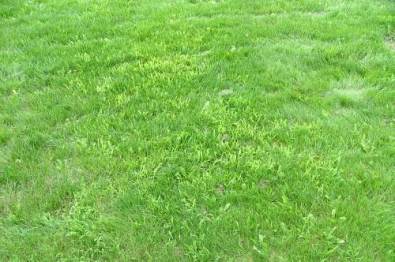The fall season provides a great opportunity to give your lawn some TLC after the stresses of summer.

This past year was one of the most difficult I can remember for keeping lawns looking good throughout the growing season. Weather certainly played a huge role in this, as – depending on where you live – you either had to deal with an overabundance of rainfall or a major lack of precipitation. Due to a number of reasons I will address below, many lawns are looking a little beat up as we enter into fall. The good news is you still have some time to get that lawn back into shape before the cold weather sets in.
One the most difficult issues we dealt with this year was crabgrass. Unfortunately, even lawns that were treated with pre-emergents were not safe from crabgrass invasion. Weather conditions (i.e. the heavy rain or dry weather mentioned previously) had a major impact on the efficacy of pre-emergent applications this spring, as it helped break down the protective barrier at a faster rate, allowing crabgrass to germinate. As a result, crabgrass was seen almost everywhere and created quite a bit of work and cost to most lawn care operators who were forced to do post-emergent treatments to try and get rid of the crabgrass.
We also saw a large number of insect infestations across the country this past growing season. From chinch bugs and bluegrass weevil in the north, to armyworms in the Tennessee Valley and tropical sod webworms in the far south, almost every region across the U.S. was faced with some form of unwanted pest.
Last but not least, we received many calls in our Weed Man offices related to turf disease that led to thinning turf, unsightly patterns in the lawn and discoloration.
Help Your Lawn Recover
If you’d like to get your lawn back into shape and help it recover, fall is the perfect time to give your lawn a good feeding and help tackle any ugly bare patches. During the cooler weather of autumn, turf grasses tend to use the nutrients from fertilizer to grow roots and fill in bare spots, which is part of the reason fall provides such an optimal window for fertilizing. In the spring, on the other hand, fertilizer nutrients are mainly used for top growth in the leaves and shoots.
Fall fertilizer contains two key ingredients: nitrogen and potassium. Both will help stimulate and repair your grass. Nitrogen aids in plant growth and helps keep grass looking green and healthy. Look for fertilizer that has a high amount of available nitrogen in a slow release form (like Weed Man’s exclusive granular fertilizer!), so that it feeds the lawn slowly, as the plant needs it.
Potassium (potash) is equally important in the fall, as it plays a vital role in healthy turfgrass development and is second only to nitrogen in the amount required for lawn growth. Potassium enacts a protective mechanism in grass plants, hardening off cell walls to fight back against damaging factors. Turfgrasses that are deficient in potassium are more prone to injury during the winter months.If possible, try to mulch your grass back into the lawn when cutting, as this will help put nutrients like potassium back into the soil as the clippings break down naturally.
Keep in mind that fall is also a great time to seed the lawn, as ground temperatures are still warm and benefit from plenty of dew at night (this will help keep the seed moist). You should have an easier time getting the seed to germinate at this time of year, which will reinvigorate any bare spots that need repair. For larger areas, aeration combined with an overseeding will really help that neglected lawn come in green and hardy next spring.
If you have any questions about your lawn, Weed Man would be happy to help. Find your local office using our locator map HERE.
Keep those lawns healthy,
Chris
